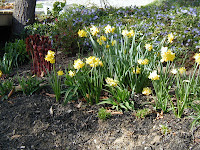
Well, the snow and ice are gone (mostly), the daffodils would like one good shower and are about ready to spring into action, and we are back from the land of sunshine. As I look at the garden I realize how nice the areas look where I cleaned up in the fall. I know that it is recommended that we leave some of this dead foliage in place to provide insulation during the winter, but I must admit that it seems that the snow did a fine job of insulating, and it is great to look out now and see those areas looking so neat. I did do some trimming of dead leaves from my Lamb's Ear and a bit of pruning, but one large section of the garden looks really neat. The rest, by comparison, seems to be screaming for attention. I think I have my work cut out for me.
Today will be a good day to plant the pansies in baskets and put them on our entry stairs. I have never understood why they call people who are wishy washy pansies. If there was ever a hardy plant that can withstand harsh weather it is the pansy. Their faces are smiling come rain, snow or cold weather.
I also have many geraniums to pot up. Last winter when I trimmed my mature plants I used the trimmings to start new plants. They are looking great now and are ready to be put into individual pots. My geraniums seem to thrive on neglect and do much better when I keep them fairly dry. My problem, when I go away, is plant sitters seem to want to water them too much and they get pretty droopy. I sometimes forget to water them for a couple of weeks at a time and they do fine. Of course summer is their favorite season, as you can see from the photo.
I was in the café at Barnes & Noble the other day and saw a lady reading a garden magazine. I said, "Are you a gardener?" and it was as if a dam broke. She spent the next five minutes telling me about her gardens. Her enthusiasm was fantastic and makes me even more excited about the start of another season of growing and tending my garden.











